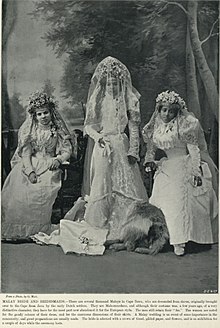
Back Kaapse Maleiers Afrikaans Kapmalaien German Malais du Cap French Կապի մալայացիներ Armenian Melayu Tanjung ID ケープマレー Japanese 케이프 말레이인 Korean Melayu Cape Malay Kaap-Maleiers Dutch Malaio do Cabo Portuguese
This article needs additional citations for verification. (September 2024) |
 Cape Malay brides and bridesmaids in South Africa | |
| Total population | |
|---|---|
| 325,000[1] | |
| Regions with significant populations | |
| South Africa Western Cape, Gauteng | |
| Languages | |
| Afrikaans, South African English Historically Malay, Makassarese, Dutch, Arabic Afrikaans[2][3] | |
| Religion | |
| Sunni Islam | |
| Related ethnic groups | |
| Javanese, Malays, Indians, Malagasy, Cape Dutch, Dutch, Cape Coloureds, Bugis, Makassar, Madura |

Cape Malays (Afrikaans: Kaapse Maleiers, کاپز ملیس in Arabic script) also known as Cape Muslims or Malays, are a Muslim community or ethnic group in South Africa. They are the descendants of enslaved and free Muslims from different parts of the world, specifically Indonesia (at that time known as the Dutch East Indies) and other Asian countries, who lived at the Cape during Dutch and British rule.
Although early members of the community were from the Dutch colonies of Southeast Asia, by the 1800s, the term "Malay" encompassed all practising Muslims at the Cape regardless of origin. Since they used Malay as a lingua franca and language of religious instruction, the community began to be referred to as Malays.
Malays are concentrated in the Cape Town area. The community played an important role in the history of Islam in South Africa, and its culinary culture is an integral part of South African cuisine. Malays helped to develop Afrikaans as a written language, initially using an Arabic script.
"Malay" was legally a subcategory of the Coloured racial group during the apartheid era.
- ^ "Malay, Cape in South Africa". Retrieved 21 March 2022.
- ^ Stell, Gerald (2007). "From Kitaab-Hollandsch to Kitaab-Afrikaans: The evolution of a non-white literary variety at the Cape (1856-1940)". Stellenbosch Papers in Linguistics (PDF). 37. Stellenbosch University. doi:10.5774/37-0-16.
- ^ "The Indonesian anti-colonial roots of Islam in South Africa". 25 August 2016. Retrieved 11 April 2022.